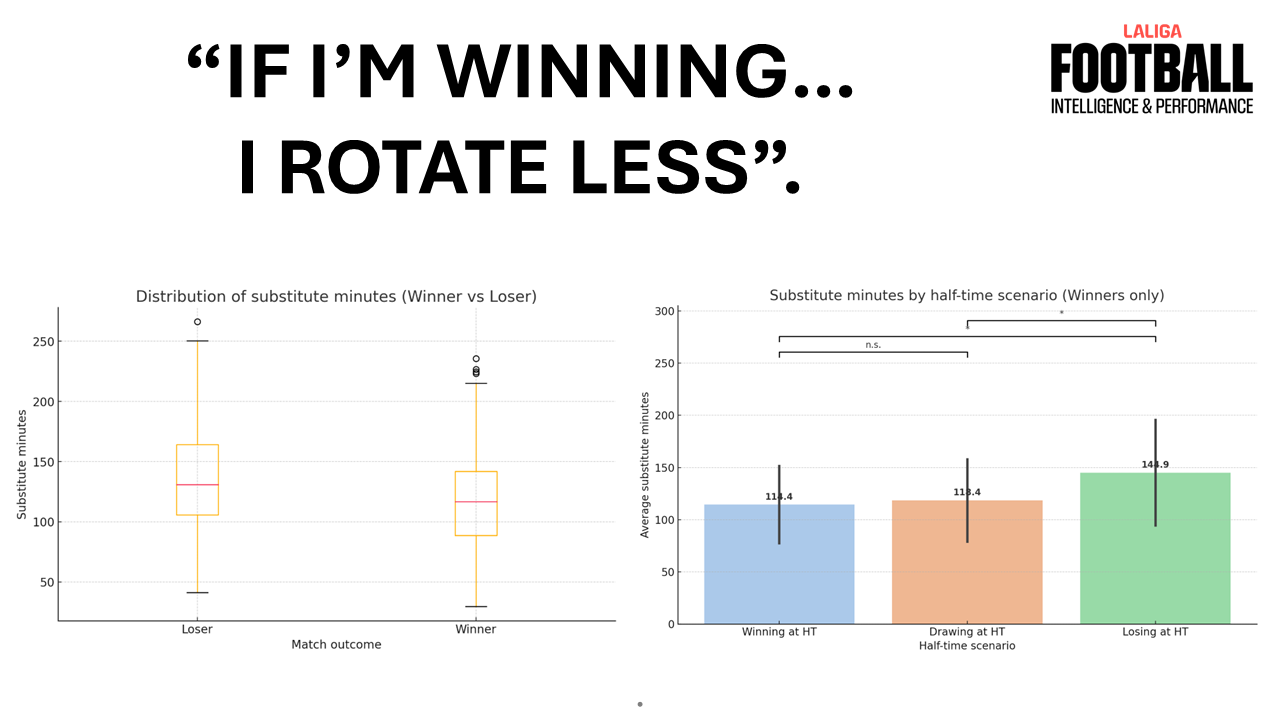
28 Ago “If I’m winning, I rotate less.” What substitutions really tell us about match control
Imagine this: halftime in a high-stakes league match. Your team is 0–1 down despite dominating possession. Do you trust your starting eleven to turn it around—or do you look to the bench for solutions? Every coach faces this dilemma, but across an entire season, substitution patterns reveal something deeper: they are a mirror of the scoreboard.
Introduction: The hidden story of substitutions
Substitutions are usually seen as tactical moves or ways to manage fatigue. But our research, conducted by the Football Intelligence & Performance Department at LALIGA, suggests they are much more: they are a barometer of confidence.
Analyzing 760 team performances from all 380 matches of the 2024/25 LALIGA EA Sports season, we found that substitution usage is strongly influenced by match status—both at half-time and full-time.
The simple truth: coaches rotate less when they are winning.
Methods: Looking at minutes, not just numbers
Most existing studies focus on the timing of substitutions—when they happen—or on whether they are offensive or defensive. We took a different perspective: the total minutes played by substitutes in each match.
This measure captures not only how many changes are made, but also how much trust coaches place in fresh players. By comparing this with match outcomes and half-time scorelines, we identified clear behavioral patterns.
Results: Substitutions mirror the scoreboard
1. Winners vs losers
- Winning teams averaged 118.5 substitute minutes per match.
- Losing teams averaged 136.7 minutes.
- That’s a gap of almost 20 minutes per match.
- In 63% of matches with a winner, the victorious team used fewer substitute minutes than its rival.
Takeaway: teams that win usually keep their core intact, while teams that lose rely more heavily on the bench.
2. What happens at half-time?
Looking only at teams that ended up winning:
- If leading at half-time (145 matches): 114.4 minutes of substitutes.
- If drawing at half-time (115 matches): 118.4 minutes.
- If losing at half-time (23 matches): 144.9 minutes.
This means comeback wins were accompanied by over 25% more substitute minutes than when the team was already ahead at half-time.
Takeaway: heavy rotation is often part of the recipe for turning a match around.
3. Statistical robustness
- Differences between winners and losers, and between half-time scenarios, were statistically significant (p < 0.01).
- The probability that these patterns are random is almost zero.
Discussion: What does this mean for coaches?
- If you’re ahead: stability is the priority. Substitutions are still made, but usually for managing effort and controlling rhythm—not to change the script.
- If you’re level: calculated changes can tilt the balance. Think of substitutions as fine-tuning rather than wholesale adjustments.
- If you’re behind: you will almost certainly need to use the bench more aggressively. Our data shows that successful comebacks are rarely achieved without significantly increasing substitute minutes.
These findings build on earlier evidence that losing teams substitute earlier and more offensively (Gómez et al., 2016; Rey et al., 2015), and large-scale studies showing over half of offensive substitutions occur while losing (Wittkugel et al., 2022). But by measuring total substitute minutes, we highlight something new: substitutions are not just tactical tweaks—they are indicators of how much control a coach feels in the match.
Limitations
- Substitution choices can be affected by injuries, squad depth, and fixture congestion.
- This study focuses on LALIGA EA Sports 2024/25, so replication in other contexts would broaden the evidence.
- Still, the consistency across 380 matches gives strong confidence in the findings.
Conclusion: Substitutions as coaching fingerprints
The conclusion is clear:
“If I’m winning, I rotate less.”
Rotation patterns reveal how coaches balance trust in their starting eleven with the need for tactical change. For analysts and performance staff, tracking substitute minutes provides an extra lens to interpret strategy, resilience, and game control.


